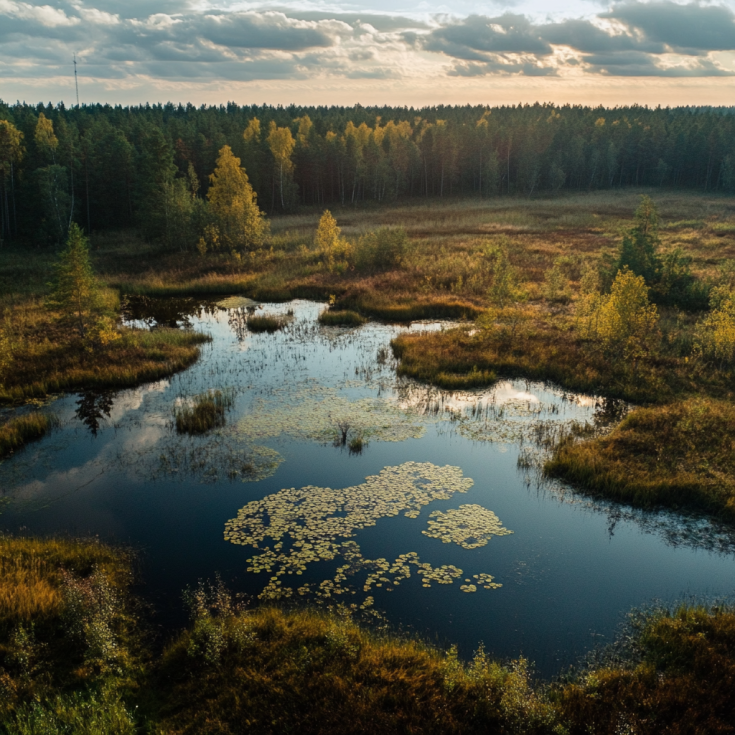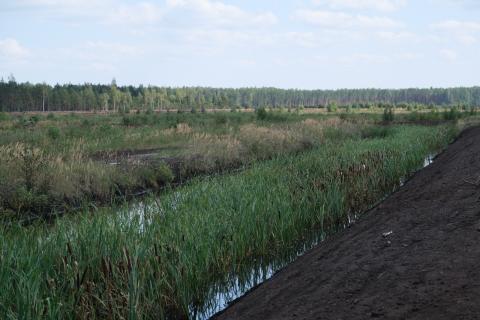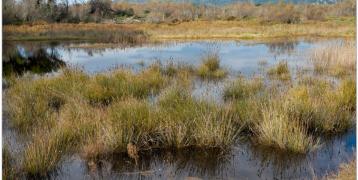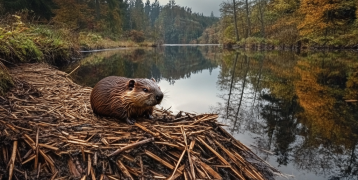Fighting climate change: Peatland restoration in Latvia

Peatlands, which include bogs and fens, are rare and unique waterlogged ecosystems that store large amounts of carbon in the form of peat (partially decayed plant material). Covering only up to 4% of the planet’s surface, they are especially important for carbon sequestration and contain up to one third of the world’s soil carbon.
This is double the amount of carbon stored in forest ecosystems. Peatlands provide a range of additional benefits and ecosystem services. They play a critical role in the water cycle by storing and filtering water, slowing peak flows and reducing the impact of floods. They are also important for biodiversity and a habitat to a range of flora and fauna.
Peatlands are found across nearly all EU member states, with the highest concentrations in North-western, Nordic, and Eastern European countries. Over 50% of these peatlands are degraded due to drainage for agriculture, forestry, and peat extraction. This degradation leads to a range of ecological issues, including:
- Loss of biodiversity
- Soil subsidence
- Increased risk of peat fires
- Salt intrusion in coastal areas
- Higher likelihood of disasters such as flooding.
Additionally, the degradation of peatlands results in the release of vast amounts of carbon into the atmosphere, significantly contributing to climate change.
Peatland restoration in Latvia
Restoration of peatlands is therefore highly important. According to Inga Retike, a Senior Researcher at the University of Latvia, and a partner in the Interreg Europe RIWET project, this is reflected in the EU Nature Restoration Law, which aims to rewet 15% of peatland areas. “Given their importance, rewetting peatlands is important to reach a number of EU objectives, including the climate neutrality and biodiversity targets, as well as goals of the Water Framework Directive”, says Retike.
Moreover, rewetted areas act as water buffers, bringing additional benefits as a protection from flooding and droughts. “Estimates show that the benefits resulting from peatland restoration are much higher than the cost, monitized around 146-3,140 euros per hectare per year through carbon sequestration and ecosystem services”, explains Retike.
Restoration of degraded peatlands has two main components, according to Retike: “Restoring natural conditions by planting native plant species and removing drainage.” Blocking drains, that were previously constructed to remove water from the peatland, allows the water table to rise again. It is also important to restore the natural water flow through the peatland ecosystem.
In Latvia, peatlands cover about 12% of the land, and peat is one of the main natural resources in the country with 39,500 hectares considered degraded and in need of restoration. To meet the demand for substrates, 4% of Latvian peatlands are used for peat extraction.
There is a big conflict of interest, because peat extraction provides a lot of jobs, but at the same time is in a direct conflict with some national and EU nature restoration and climate targets.
Therefore, the Latvian approach lies in rewetting the peatlands and promoting paludicultures - a combination of activities that will not hinder the restoration efforts but will also have economic benefits, including local communities.
Research institutions and NGOs in Latvia have partnered to co-create and test the most suitable paludiculture practices for degraded peatlands. Apart from growing sphagnum moss and restoring peatland habitats to boost biodiversity and support native species, rewetted areas can be used to grow berries (like cranberries, lingonberries and blueberries), for bee pastures and growing medicinal plants (like marsh trefoil, sweet flag, sweet gale, meadowsweet). Applying agrovoltaics, thus integrating wetland agriculture with solar energy production, is another option.
Peatlands are in most cases owned by the nation, but they are often leased to private bodies. In the past these have been also foreign companies that just excavated the land and left.
“The problem is that the foreign companies have used the land, taking all the economic benefit out of the country and now the municipalities are left with a degraded land, and bear the responsibility for the restoration and rewetting of peatlands, for which they have no available funds from the State”, Retike explains about the complicated situation in Latvia. Now there is a national regulation, under which the land users are obliged to restore the land, but the control of the process could still be improved.
When implementing this rewetting, there was a lack of knowledge, experience and exchanges among stakeholders, as well as lack of trust originating from first unsuccessful rewetting experiments. “We began to take stakeholders to study visits abroad, where they can see that the method works, and it has for years”, says Retike.
Protection and restoration of peatlands is highly important. EU regions should strengthen regulations to prevent or halt harmful operations like peatland drainage for agriculture and forestry, and inadvertent loss of peatlands for other uses (like minerals, oil and peat extraction). They can initiate medium-term plans for phasing-out harmful operations that are already taking place and establish licenses that require more sustainable practices and peatland restoration obligations for the transition period. It is important to make sure the companies using peatland have a dedicated budget for restoration once the excavation is complete.
The Latvian example shows that sustainable management of peatlands, where restoration is combined with economic benefits, is possible.
Further resources
Read more about the featured good practice of this story: Rewetting practices for degraded peatlands to boost biodiversity and mitigate climate change. And discover more of our resources below.







